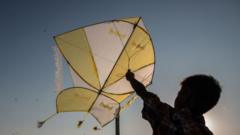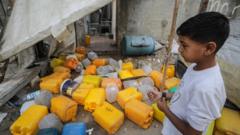Despite safety warnings from airport officials, children in Indonesia persist in flying kites near Soekarno-Hatta International Airport, igniting a tug of war between this cherished cultural activity and flight safety concerns.
Kites vs. Planes: A Cultural Clash in Indonesia's Skies

Kites vs. Planes: A Cultural Clash in Indonesia's Skies
The battle between kite enthusiasts and aviation authorities heats up as children continue to practice a beloved pastime near Jakarta’s busy airport.
At a scenic paddy field just two kilometers from Jakarta's Soekarno-Hatta International Airport, a vibrant contest unfolds between the soaring kites and the roaring planes above. Children, filled with excitement, tug on their colorful kite strings while keeping a wary eye for the airport officials patrolling the area. “If they take my kite, I’ll be sad, but I can always make another one,” says seven-year-old Atif, revealing the resilience that epitomizes this spirited pastime.
Kite flying in Indonesia, particularly during the summer holidays, is a cherished tradition steeped in cultural significance. However, recent disruptions involving kites interfering with flight operations have put authorities in a challenging position. During a three-day span in July, numerous flights faced delays and diversions due to kites encroaching near the airport. The head of the airport authority, Putu Eka Cahyadi, emphasized that these kites, described as "moving obstacles," pose serious risks to flight safety.
The urgency of solving the kite conundrum is underscored by past incidents; a helicopter crash in Bali attributed to entangled kite strings and previous runway close calls serve as stark reminders of the potential dangers. Despite these risks, the allure of kite flying remains strong. Transport Minister Dudy Purwagandhi has urged a collaborative effort between regional governments and airport authorities to mitigate the safety threats presented by kites.
In Indonesian culture, kite flying is not merely recreational; it encompasses various traditional aspects, such as religious ceremonies and agricultural practices. Experts like Asep Irawan from the Indonesia Kite Museum advocate for preserving this heritage while emphasizing the need to educate younger generations about the attached risks. Authorities have attempted to redirect children's interests towards safer sports like football and badminton, yet the appeal of kites remains irresistible.
Legal repercussions loom for those caught flying kites near airports, with potential prison sentences and hefty fines in place. External threats also linger outside airstrips, as urban kite flying has accounted for tragic incidents, including the death of a child hit by a car in pursuit of a kite.
The children in the paddy field express their frustration at the dwindling green spaces in Jakarta, which have severely limited their kite-flying options. “There’s nowhere else around here,” laments 17-year-old Rasha, a passionate kite maker. Despite the risks and past reprimands, their love for kite flying continues to shine, illustrating the complex interplay between cultural identity and safety in Indonesia's ever-evolving landscape.
















